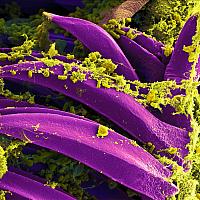You are here
News Release
Thursday, June 5, 2014
Striking, cutting-edge scientific images now on display at Washington Dulles International Airport
Many showcase NIH-supported research.

Stunning scientific images of blood, brain, bacteria, viruses and more, enlarged by as much as 50,000 times, are on display in an exhibit called “Life: Magnified,” on view through November 2014 at Washington Dulles International Airport’s Gateway Gallery. The gallery, en route to Concourse C, is in a two-level walkway through which about 2.5 million passengers pass each year.
The display is cosponsored by the National Institutes of Health’s National Institute of General Medical Sciences (NIGMS), the American Society for Cell Biology (ASCB) and the Metropolitan Washington Airports Authority’s Arts Program. The program uses the arts to enhance travel experiences at Dulles International and Reagan National Airports.
“These images show science that shines like art. Many of these stunning pictures were created by researchers who work at or are funded by NIH, as part of their quest to better understand basic life processes and gain insights about health and disease,” said NIH Director Francis S. Collins, M.D., Ph.D.
“We hope this exhibit helps inform the public about cutting-edge biomedical research and how visualizing biology, with all its complexity and beauty, can lead to important, medically relevant advances,” said NIGMS Director Jon R. Lorsch, Ph.D.
“Many of the images come from organisms like mice, fruit flies and zebrafish. These organisms have much in common with us, including a large proportion of their genes, the way their tissues and organs develop, and how their bodies function. Studying them speeds scientific progress to learn more about our own biology,” Lorsch added.
The 46 colorful backlit enlargements in the exhibit were selected from more than 600 submitted by researchers. In addition to the variety of organisms, the collection features a wide range of cell types and imaging techniques.
“The Gateway Gallery has traditionally welcomed passengers to Dulles International through its unique and engaging art displays,” said Christopher U. Browne, Washington Dulles International Airport manager. “This exhibit will add to the enjoyment of the airport experience while offering travelers an intriguing, up-close view of life on a microscopic level.”
“This eye-popping show lets visitors take a dazzling trip through the cellular world, which is both foreign and as close as their own skin,” said ASCB Executive Director Stefano Bertuzzi.
Although only passengers who pass through airport security can see the exhibit itself, an online gallery is available at http://www.nigms.nih.gov/Education/life-magnified/Pages/default.aspx. This site includes high-resolution versions of all of the images in the collection, along with longer captions than in the airport exhibit. All of the images are freely downloadable for non-commercial purposes.
To arrange an interview with NIGMS Director Jon R. Lorsch, Ph.D., contact the NIGMS Office of Communications and Public Liaison at 301-496-7301 or info@nigms.nih.gov.
NIGMS is a part of NIH that supports basic research to increase our understanding of life processes and lay the foundation for advances in disease diagnosis, treatment and prevention. For more information on the Institute's research and training programs, see http://www.nigms.nih.gov.
About the National Institutes of Health (NIH): NIH, the nation's medical research agency, includes 27 Institutes and Centers and is a component of the U.S. Department of Health and Human Services. NIH is the primary federal agency conducting and supporting basic, clinical, and translational medical research, and is investigating the causes, treatments, and cures for both common and rare diseases. For more information about NIH and its programs, visit www.nih.gov.
NIH…Turning Discovery Into Health®




